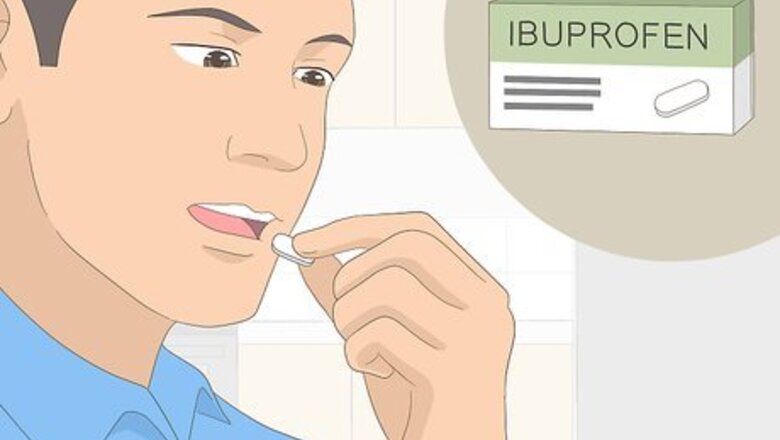
views
- Use over-the-counter medication or a hernia truss to manage pain and inflammation.
- Prevent worsening your hernia by avoiding heavy lifting, gently exercising your core, and trying not to strain while using the bathroom.
- Seek medical attention right away if the hernia turns red or purple or you experience severe pain, nausea, vomiting, or blocked bowels.
Managing Hernia Pain at Home
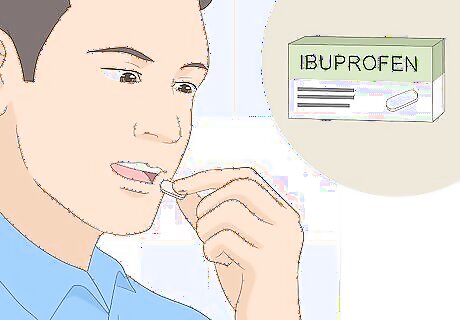
Take over-the-counter pain medicine to relieve your hernia pain. Try nonsteroidal anti-inflammatory drugs (NSAIDs) like aspirin (Bayer, Excedrin), ibuprofen (Motrin, Advil), or naproxen sodium (Aleve) to alleviate some pain and swelling. Follow the recommended dosage on the bottle and don’t exceed the daily limit. If you find your pain doesn’t get better or if you keep taking more and more medication, speak with your doctor about stronger treatment. If you take a blood thinner, always check with your doctor before using pain medication. They may want you to take something different so it doesn’t interfere with the blood thinner. Types of Hernias: Almost all hernias eventually need to be treated through surgery, especially if they’re bulging or causing you pain. Common types of hernias include: Inguinal hernia: This type of hernia is in the groin area; it most often affects men, though women can experience it, too. Femoral hernia: This hernia is located around the top of your inner thigh, caused by part of your intestines pushing through your groin. These are most common among older women. Hiatal hernia: This hernia appears on your abdomen as part of your stomach protrudes into your chest cavity. Umbilical hernia: This occurs when tissue pushes through your abdomen near your belly button. It can affect both infants and adults.
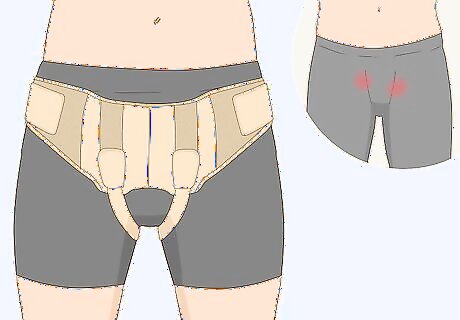
Relieve discomfort from an inguinal or femoral hernia with a truss. A truss is a supportive undergarment that helps keep your hernia in place (it’s a temporary solution to help relieve pain until you can have surgery). Since inguinal hernias are more common in men, many trusses are designed for male anatomy (but there are unisex trusses and trusses for women, too). Visit your doctor so they can make sure your truss is properly fitted, but if you’re in a pinch, just buy one online. Other hernia supports include: Hernia briefs for men and women (undergarments that apply uniform pressure to the abdomen and groin) Abdominal wraps (wraps that apply uniform pressure all around the abdomen, usually to help with umbilical hernias) Most inguinal hernias need surgery to be repaired, but if your hernia is really small and not causing you pain, your doctor may wait and keep an eye on it.
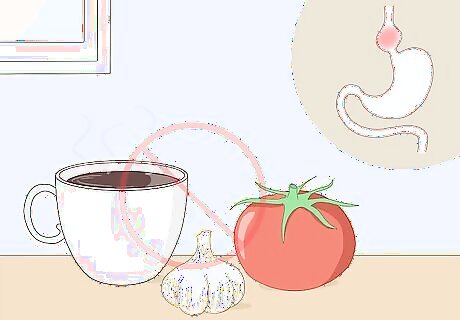
Cut out heartburn-causing foods and avoid large meals for hiatal hernias. Enjoy multiple small meals throughout the day instead of 3 larger ones (this will put less pressure on your stomach so you’re more comfortable all day long). Cut out caffeine, chocolate, garlic, tomatoes, and other fatty or fried foods that can cause heartburn, too. Try not to lay down after you eat for several hours. Hiatal hernias are the one type of hernia that sometimes don’t need surgery (especially when symptoms can be managed through diet and over-the-counter antacids). If your symptoms increase over time, though, surgery may become the best solution.

Eat a fiber-rich diet to make bowel movements softer and easier to pass. Straining your muscles can aggravate your hernia, and constipation can make things worse. Add lots of fruits and vegetables to your daily diet, and consider taking a fiber supplement to help things move smoothly. Eat more oatmeal, nuts, beans, popcorn, chia seeds, and whole grains—they’re great high-fiber food choices! Try to eat at least 21-25 grams of fiber per day if you’re a woman, or 30-38 grams per day if you’re a man. Make sure to stay hydrated and drink plenty of water every day, too.
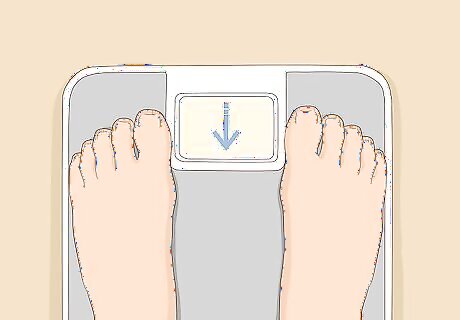
Lose weight to take pressure off of your abdomen. This can be helpful for all types of hernias—weight loss allows the abdominal wall to relax, which helps the hernia opening close more easily and prevents future hernias. Modify your diet to include lean proteins and more fruits and vegetables, and try adding in some gentle exercise every day to lose weight. Hernias can be uncomfortable and it may be hard for you to exercise. Try going for short 15-minute walks, or go to the pool and slowly swim laps. Be gentle on yourself so you don’t aggravate the hernia more. Some surgeons may also recommend losing weight before surgery to minimize complications and speed up your recovery afterward.

Try natural remedies like ginger root or essential oils. While there’s no hard evidence that natural fixes are effective at treating hernia pain or inflammation, incorporating a holistic remedy or two into your self-care routine might support tried-and-true treatments. For example, try massaging castor seed oil over your hernia. Supposedly, this helps the skin retain moisture and hold the hernia in a natural, comfortable position. Add ginger root to teas or your favorite meals. Ginger is said to help reduce inflammation, which may make your hernia feel more comfortable. Mix a glass of milk with a pinch of turmeric or a spoonful of licorice herb powder to reduce inflammation. Drink plenty of herbal teas, or try a glass of aloe vera juice before each meal for its soothing, anti-inflammatory effects. Sprinkle extra black pepper on your food to suppress acid reflux and stimulate healing.
Preventing Further Damage
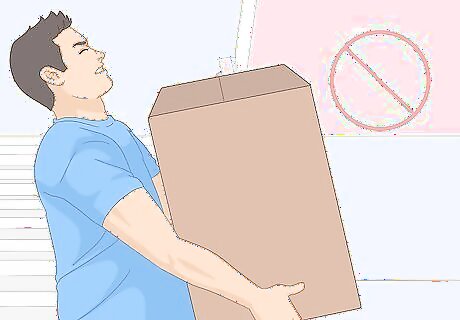
Lift bulky or heavy objects safely to avoid abdominal muscle strain. Instead of bending over at the waist to pick up heavy items, bend your knees so you’re squatting. Bring the object close to you and then straighten your legs and stand up. Keep the heavy object at chest level and try not to twist and turn too much. For heavy items you can’t lift yourself, use a dolly. Wedge the bottom of the dolly under the item, then pull the dolly’s handle to lift the object. From there, wheel it wherever it needs to go.
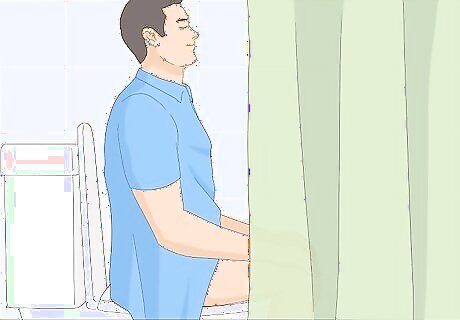
Relax while going to the bathroom so you don’t strain your groin area. This is a little counterintuitive, but try to not push super hard when you have a bowel movement. Take your time and let your body slowly work things out—it may take longer than usual, but it’s gentler on your body and can prevent further damage. Go to the bathroom whenever you feel the urge instead of holding it in for long periods. Try putting your feet up on a short stool to make those muscles relax and help you go to the bathroom more easily. Add a hot cup of coffee to your morning routine. The heat and caffeine can help things get moving. Maintain a high-fiber diet to help your bowel movements. Fiber can also help prevent hernias and manage discomfort if you already have one.
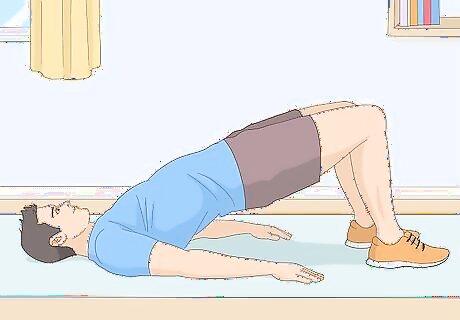
Strengthen your abdominal muscles to prevent additional hernias. Weak muscles make it easier for your internal organs to break through your abdominal walls. Exercise your core gently—too much pressure or exertion could actually cause a hernia, so start slow and stop any exercises that cause you pain. Try doing crunches every day. Lay on your back with your knees bent and put your hands behind your head. Use your ab muscles to lift your shoulders 3 to 4 in (76 to 102 mm) off the ground before lowering yourself back to the ground. Aim for 3 sets of 10 reps. Swim for low-resistance strength training. The support of the water makes it easier to exercise without straining your abs as much. Start slow if you’re new to swimming or doing water exercises, and enjoy your time in the water! Try yoga to gently stretch and tone your core. If you’ve never done it, consider signing up for a beginners’ class.
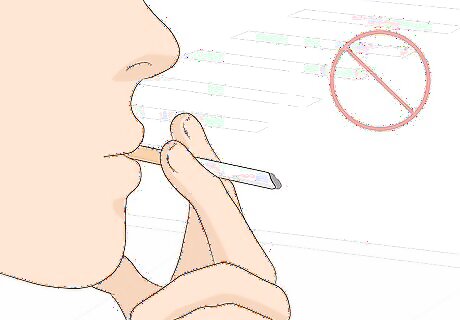
Quit smoking to improve lung health and eliminate excessive coughing. There are lots of reasons to stop smoking, and preventing hernias is one of them! Chronic coughing strains your muscles in both your abdomen and groin, which can make an existing hernia worse. Start curbing your smoking habit, or just quit cold turkey. It can be extremely hard to stop smoking. If you’re having a hard time, talk to your doctor. They may be able to help make the transition easier.
Seeking Medical Care
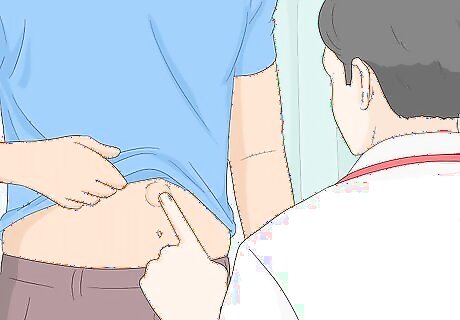
See your doctor for an official diagnosis before treating yourself. You will likely recognize the signs and symptoms of a hernia on your own, especially if it’s large. However, it’s easy to misdiagnose yourself, so see your doctor to make sure what you have is a hernia. Your doctor will make a proper diagnosis so you can be sure you’re getting the right treatment. Your doctor will do a physical examination to check for a hernia. They’ll look at the area and may press into it with their hands. In some cases, your doctor may do imaging tests to view the hernia like an ultrasound, CT scan, or MRI. Hernia symptoms include a bulge protruding from your abdomen or groin, a burning or sore feeling at the bulge, and groin or abdominal pain (especially when bending over or lifting).
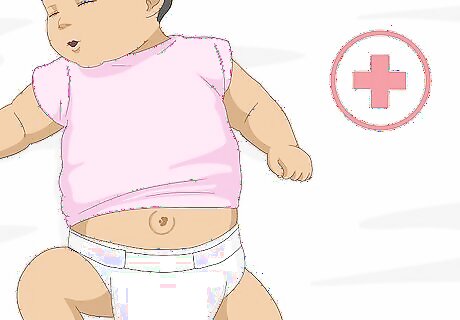
Talk with your child’s pediatrician if they develop an umbilical hernia. For infants and children under 5, always check with your pediatrician to see what treatment they recommend. Many times, an infant’s hernia will close on its own over time. If it hasn’t gone away by the time your child is 3-4 years old, they may need a small procedure to have it fixed. Umbilical hernias are common with infants, and they usually don’t cause your child any pain or discomfort.
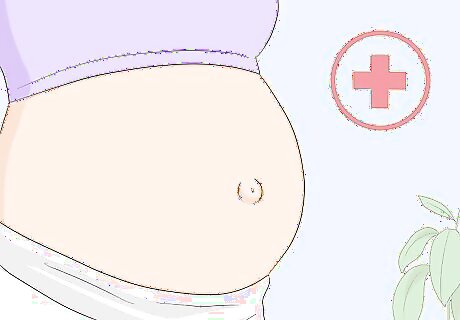
Let your doctor know if you have a hernia while you’re pregnant. Because of the extra strain on your body, hernias are fairly common among pregnant people. If you |suspect you have a hernia, talk to your doctor so they can check it out. Your doctor will most likely want to wait until after birth and recovery before treating the hernia if you need surgery, but may have to operate if the hernia symptoms are severe. If your doctor decides to wait until after birth, rest assured that the hernia won’t endanger you or your pregnancy (they wouldn’t decide to wait if there was a severe risk of complications). If you need hernia surgery during pregnancy, it will most likely be scheduled during the second trimester. The severity of your symptoms and the state of your pregnancy determine what treatment your doctor pursues. A laparoscopic surgery with a mesh implant is typical.
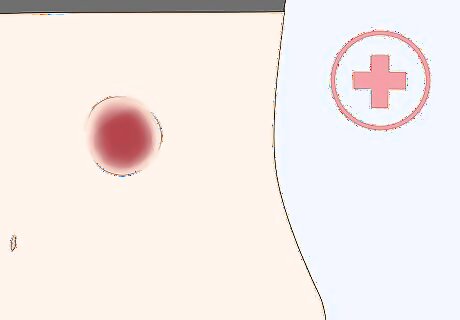
Visit your doctor ASAP if your hernia turns dark red or purple. This can be a sign that your hernia is strangulated. This means your hernia may be cutting off the blood flow to part of your intestines and could require urgent medical treatment. Go to the doctor quickly because you may need an emergency surgery. Try your best to not worry or panic. Hernia surgeries are common and are often quick and easy to perform.
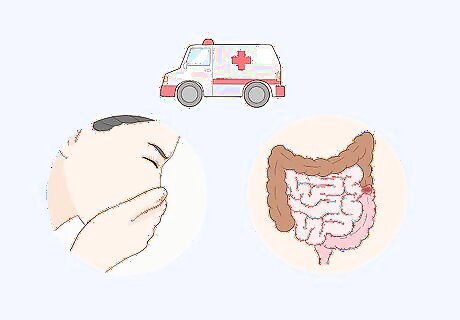
Seek emergency care for pain, nausea, vomiting, or blocked bowels. If your hernia is strangulated (blocking a section of your intestines), your bowel movements will get caught behind the hernia, causing pain, nausea, vomiting, and bloating. You will likely not be able to pass gas or have a bowel movement. See your doctor or go to the emergency room right away if this happens because you’ll likely need emergency medical treatment. This is a treatable condition, though it can be really scary at the moment. As soon as you suspect a problem, get medical attention so you can get back to normal as soon as possible.
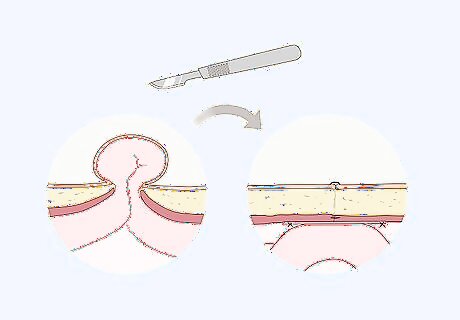
Have a surgery to correct your hernia and prevent future ones. These procedures are generally pretty quick and you usually get to go home the same day. The surgeon will make a small incision near the hernia and push it back into place. From there, they will sew and reinforce the tear with a mesh screen or other material so that the hernia will be less likely to protrude again. Make sure to follow all recovery instructions after your surgery. Take it easy, avoid heavy lifting for a while, and take your prescribed pain medication.















Comments
0 comment